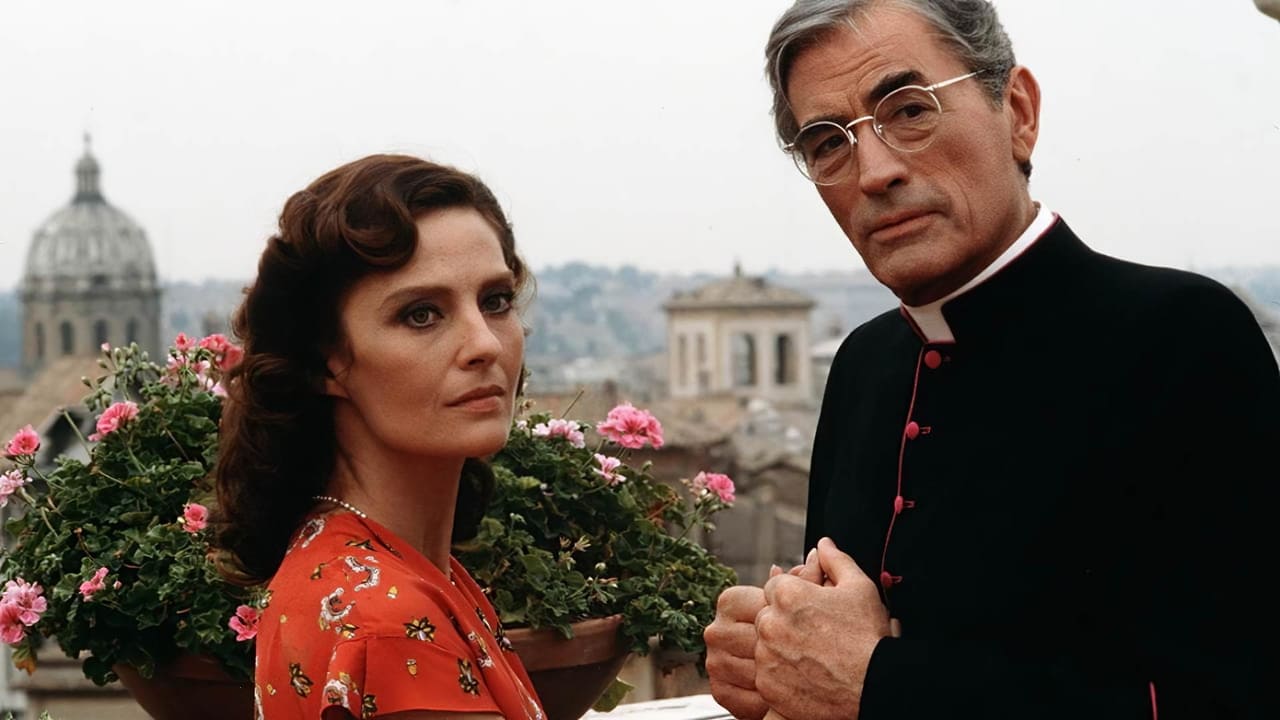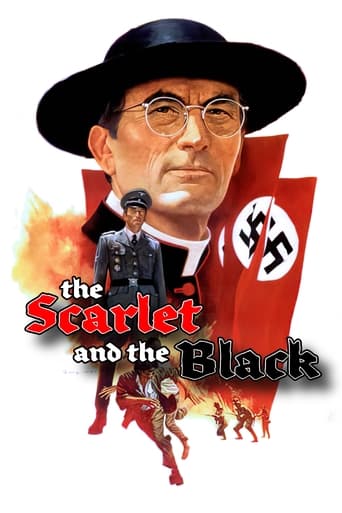


Some things I liked some I did not.
... View MorePeople are voting emotionally.
... View MoreGood start, but then it gets ruined
... View MoreThe film's masterful storytelling did its job. The message was clear. No need to overdo.
... View MoreAs it is, this tv movie is two and a half hours, but it could have easily been stretched out and doubled its running time. The Scarlet and the Black is such a fascinating story, and it's also based on a true one. The end of the movie is not the end of the true story, and if you look up the facts afterwards, you'll wish the movie continued documenting the remaining decades of what happened! But no spoilers here, don't worry.Bless his heart, but Gregory Peck just can't do accents. He plays an Irish priest, but you'll just have to forgive him his terrible attempt at an Irish accent; if you don't, you might not make it through the movie. Everything else in the film is fantastic, though, so I recommend you forgive him. His character is an active participant in the Italian Resistance in Nazi-occupied Rome. He smuggles refugees and prisoners of war out, but since he's such a big-wig in the religious community, Christopher Plummer, a big-wig in the Nazi community, can't arrest him. The film shows their struggle to outsmart each other, and the risks Greg takes to save lives, even when risking his own.My favorite scene in the film is so tense, I found myself actually nibbling on my fingernail until the scene was over. Christopher Plummer has threatened Gregory Peck with arrest should he cross a painted line on the street outside the Vatican. Chris stands in a neighboring window, watching, as Greg approaches the line. He aims a gun at Greg, and as Greg looks up and sees his nemesis, he maintains his eye contact as he paces back and forth parallel to the line, occasionally swinging his leg over the line to call Chris's bluff. It's a fantastic scene and a perfect representation of the rest of the film. Both leads-despite Greg's lack of accent-are wonderful. Up until recently, I haven't appreciated Christopher Plummer's acting talents, and this is one of the movies that helped me cross over. He's really wonderful in the role, extremely averse but somewhat amused and even admiring of Greg's tenacity, and strict but fearful for his family. I keep waiting for a remake of this movie, starring Tom Hanks and Christoph Waltz. Even if the remake started when this movie ended, there would be plenty of fascinating material to create an irresistible film. Until Hollywood decides to make a modern reboot, watch the original. It's really very good, and you can see a very handsome Christopher Plummer in his prime.
... View MoreMany movies have been made about the Holocaust and other Nazi atrocities of World War II. But, only a few films have been made about the heroes of the pogrom. Yet, there were many thousands of non-combatants, civilians and religious, who hid Jews and helped them escape. Many also helped escaped POWs and downed Allied flyers. Poland was especially brutalized by the Nazis. Yet, it alone had more than 4,000 heroes of the Holocaust who have been named Righteous Among the Nations by Yad Vashem, the Israeli Holocaust memorial center in Jerusalem. Msgr. Hugh O'Flaherty may be the best known among Catholic clergy for his efforts – no doubt in some part due to Gregory Peck playing him in this 1983 movie for TV. The film is loaded with talented actors. O'Flaherty operated out of his office in the Vatican. He organized a network that helped 6,500 Jews and Allied escapees flee the Nazis. His nemesis, played by Christopher Plummer in this film, was SS Col. Herbert Kappler. Other leading roles were John Gielgud as Pope Pius XII and Raf Vallone as Father Vittorio. This movie is an excellent account of that true story. Only one aspect of the film isn't superb – the musical score. In some dramatic or suspenseful scenes, the music is terrible. Even with that, though, this is an excellent movie. The story is based on a 1983 book by J.P. Gallagher, "The Vatican Pimpernel." A new novel about Fr. O'Flaherty and his WW II rescue network just came out in 2012. "Hide & Seek: The Irish Priest in the Vatican who Defied the Nazi Command" was written by Stephen Walker. A few other excellent films tell the WW II stories of some clergy who were true heroes. A 1985 movie, "The Assisi Underground," is about a Franciscan Padre, Rufino Niccacci, who organized a massive network to hide Jews and help them escape. Many priests, nuns and lay people helped in this effort. Padre Rufino and Bishop Nicolini were named Righteous Among the Nations after the war by Yad Vashem. "Au Revoir Les Enfants' is a French movie made in 1987. It tells the story of Father Jacques de Jesus, a Carmelite headmaster of a boy's boarding school in Avon, France. Fr. Jacques hid Jewish boys among the students and put noted Jewish botanist Lucien Weil on the faculty. In 1985, Yad Vashem, honored the priest as one of the "Righteous Among the Nations." This film was made two years later by French filmmaker Louis Malle who had been a student under Fr. Jacques.In August of 2014, a movie was made about St. Maximillian Kolbe. He was a Polish priest who was sent to Auschwitz. Kolbe asked the commandant to take him in the place of a Jewish man who was to be killed. Kolbe died Aug. 14, 1941. Pope John Paul II canonized him a saint on Oct. 10, 1982, and the Jewish man whose life he saved was at Kolbe's canonization in Rome. There were many other clergy and religious heroes of WW II. Archbishop Giovanni Ferrofino was an Italian diplomat who helped save 10,000 Jews flee Nazi Europe. Mother Riccarda Beauchamp Hambrough was an English nun who hid 60 Jews in her cloister in Italy. But many stories may never be known, because so many Catholic Priests were killed by the Germans. In Dachau Concentration Camp, 2,600 Catholic priests from 24 different countries were killed. And, between 1939 and 1945, the Nazis killed an estimated 3,000 priests in Poland. Of those, 1,992 died in concentration camps. An interesting aspect of "The Scarlet and the Black" is the portrayal of Pope Pius XII as cautious about the church making overt steps to save Jews. That may be a fair and accurate depiction. The Pope wouldn't want to give the Nazis cause to invade the Vatican and imprison more clergy. In recent years, some critics have said Pius didn't help the Jews, or do enough to help them. But, post-war books and statements by escapees and Jewish leaders praised Pius for his discreet aid to Jews. When Pius died in 1958, the chief Rabbi of Rome, Elio Toaff, said "Jews will always remember what the Catholic Church did for them by order of the Pope during the Second World War."Indeed, in the early years of the war, Pope Pius was one of the few world leaders who took on Hitler and the Nazis. The New York Times, on Christmas Day 1941, carried an editorial that praised his efforts. "The voice of Pius XII is a lonely voice in the silence and darkness enveloping Europe this Christmas." The following year, Christmas of 1942, The Times again praised Pius in an editorial: "This Christmas more than ever he is a lonely voice crying out of the silence of a continent."Since then, The Times has admitted to criticism that it hid news coverage or played down reports about the Holocaust during the war. Between 1939 and 1945, the paper ran 23,000 front-page stories. Of those, 11,500 were about the war. Only 26 were about the Holocaust. Most mentions of death camps, Nazi atrocities or persecution of the Jews were buried inside the paper. In 1996, The Times said that criticism of its reporting of the holocaust is valid. An irony in this is that during World War II, the owner and publisher of The New York Times was Arthur Hays Sulzberger, a Jew.
... View MoreThe Scarlet and the Black is billed as the real life story of Monsignor Hugh O'Flaherty, an Irish Roman-Catholic priest who rescued Allied POWs from German captors. The year is 1943. Italy has surrendered. The Germans now occupying Rome are resisting an invasion by the US and the UK.Monsignor O'Flaherty (Gregory Peck), an Irish national runs an underground organization to provide safe haven to escaped US and British PoWs and other refugees. Father O'Flaherty is dogged by SS LTC Herbert Kappler (Christopher Plummer) who is in charge of military police operations. Anxious to prevent US and UK escapees from fleeing into the Vatican, theoretically an independent country recognized by The Reich, the Colonel has painted a white line across St. Peter's Square to mark the limits of Vatican sovereignty. It's quite a cat and mouse game with Father O'Flaherty one step ahead of the SS both in the movement of US and UK personnel through Rome and in the war of wits. Audaciously, O'Flaherty recommends democracy to the German SS as an alternative to their brutish ways.The made for TV movie suffers from an important historical lapse. Though Pope Pius as played by Sir John Gielgud is antagonistic to the Germans, real life Pius armed his Swiss Guard and instructed them to deny entry to the Vatican enclave to allied escapees. The role of Pius in World War II will always be a matter of controversy.O'Flaherty and this story are supposedly based on real life events. If so, O'Flaherty was playing cat and mouse not only with the Germans but also with the Pope who at this point was unwilling to get involved. The big question I have is Why would O'Flaherty help Britons who were his country's enemy only recently expelled from his homeland or Americans who were allied with Britain? The film does not answer the question, but proceeds to show O'Flaherty help the wife and children of his nemesis escape retribution from the victors as an humanitarian gesture.It is a good movie nonetheless and highly recommended.
... View MoreBased on a true story set during World War II in Rome, this made for television movie stars Gregory Peck in yet another fine role,(as if he could ever do a bad one.)The supporting cast is also amazing with fine performances from Christopher Plummer and Sir John Gielgud, with Raf Valone, Vernon Dobchef and Walter Gotell among others. It is a fast paced history/war/drama/thriller in the mold of such films as "The Third Man," and "The Thirty Nine Steps." The frenetic musical score of Ennio Morricone (The Good, The Bad and The Ugly) helps to keep the pace on the edge of you seat. This is simply some fine film making at its very best, and I highly recommend it, if you have not already had a chance to see it. Just a beautiful film.
... View More